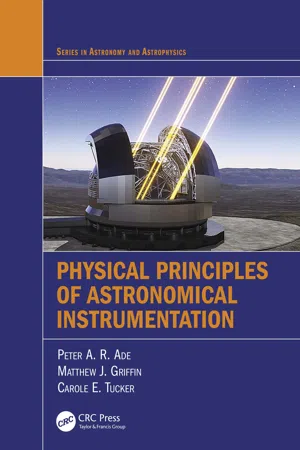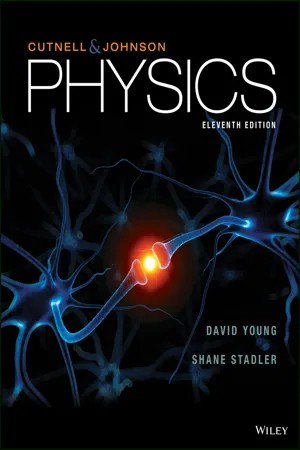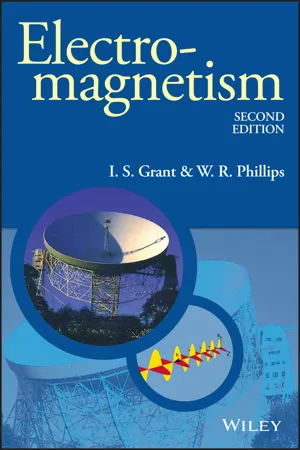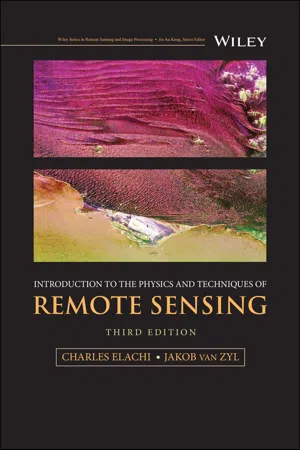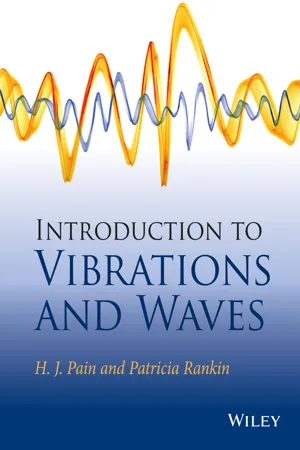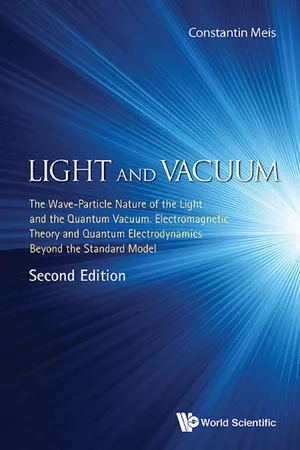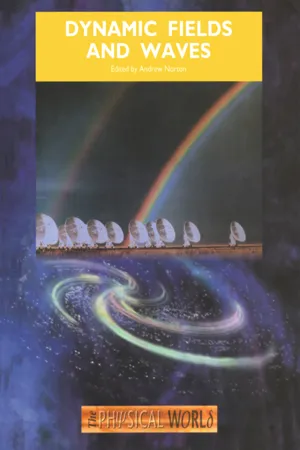Physics
Standing Electromagnetic Waves
Standing electromagnetic waves are formed by the superposition of two waves traveling in opposite directions. They occur when the frequency and wavelength of the waves are such that they interfere constructively and destructively, resulting in nodes and antinodes. These waves are characterized by their stationary nature and are commonly observed in various natural and man-made systems, including antennas and resonant cavities.
Written by Perlego with AI-assistance
Related key terms
Related key terms
1 of 4
Related key terms
1 of 3
9 Key excerpts on "Standing Electromagnetic Waves"
- Peter A. R. Ade, Matthew J. Griffin, Carole E. Tucker(Authors)
- 2021(Publication Date)
- CRC Press(Publisher)
1 Review of Electromagnetic Radiation
1.1 Introduction
In this chapter, we review the basic properties of electromagnetic (EM) radiation that are pivotal to our understanding of the radiation detected from astronomical sources and the design of instrumentation to characterise it.EM radiation originates from the acceleration of charged particles. First, consider a charged particle that is made to oscillate back and forth in simple harmonic motion around some location in space. In forcing this motion, the particle is being continually accelerated. As it moves, the electric field which it produces oscillates and, as a moving charge constitutes a current, the oscillation of the charge also leads to an oscillating magnetic field. Therefore, an oscillating charge produces oscillating electric and magnetic fields, which are the basis of EM radiation.While EM radiation can be described as a travelling oscillation of the electric and magnetic fields (the wave picture), it can also be described as a stream of discrete packets of energy (the photon picture). As we shall see, the wave picture is usually adopted for long-wavelength/low energy radio waves while the photon picture for higher energy radiation in the visible to γ-ray regions of the spectrum. In between, at millimetre to infrared wavelengths, both conceptualisations can be used, depending on the circumstances. We begin with the wave picture, which can be derived from Maxwell’s equations for the electric and magnetic fields.1.2 Mathematical Description of Waves
A transverse travelling wave involves oscillation in a direction perpendicular to the direction of propagation; EM waves are transverse waves. A snapshot of a travelling electric field wave moving in the z direction is illustrated in Figure 1.1 .FIGURE 1.1Sinusoidal electric field travelling wave of wavelength λ .E is the magnitude of the electric field. The wave’s frequency, ν , and wavelength, λ , are related throughv = ν λ, where v- eBook - ePub
- John D. Cutnell, Kenneth W. Johnson, David Young, Shane Stadler(Authors)
- 2018(Publication Date)
- Wiley(Publisher)
The picture shows only the part of the wave traveling along the + x axis. The parts traveling in the other directions have been omitted for clarity. It should be clear from the drawing that an electromagnetic wave is a transverse wave because the electric and magnetic fields are both perpendicular to the direction in which the wave travels. Moreover, an electromagnetic wave, unlike a wave on a string or a sound wave, does not require a medium in which to propagate. Electromagnetic waves can travel through a vacuum or a material substance, since electric and magnetic fields can exist in either one. Figure 24.3 This picture shows the wave of the radiation field far from the antenna. Observe that E → and B → are perpendicular to each other, and both are perpendicular to the direction of travel. Electromagnetic waves can be produced in situations that do not involve a wire antenna. In general, any electric charge that is accelerating emits an electromagnetic wave, whether the charge is inside a wire or not. In an alternating current, an electron oscillates in simple harmonic motion along the length of the wire and is one example of an accelerating charge. All electromagnetic waves move through a vacuum at the same speed, and the symbol c is used to denote its value. This speed is called the speed of light in a vacuum and is c = 3.00 × 10 8 m/s. In air, electromagnetic waves travel at nearly the same speed as they do in a vacuum, but, in general, they move through a substance such as glass at a speed that is substantially less than c. The frequency of an electromagnetic wave is determined by the oscillation frequency of the electric charges at the source of the wave. In Figures 24.1–24.3 the wave frequency would equal the frequency of the ac generator. Suppose, for example, that the antenna is broadcasting electromagnetic waves known as radio waves - eBook - ePub
- I. S. Grant, W. R. Phillips(Authors)
- 2013(Publication Date)
- Wiley(Publisher)
monochromatic . (The name is taken from the visible part of the spectrum, but it is usually applied to waves that oscillate sinusoidally at any fixed frequency.) The power radiated by the coil, averaged over a complete cycle of the current, is constant in the steady state. The power is carried away by the radiated waves, and the same average power crosses any sphere whose centre is at the position of the coil. If we consider two such spheres, one closer in than the other, the energy crossing unit area per second (in a direction along a particular line drawn away from the coil) over the inner sphere is greater than the energy crossing unit area per second in the same direction over the outer sphere. The average energies depend on the amplitudes of the electric and magnetic fields at the appropriate points on the two spheres, and hence the field strengths decrease with increasing distance from the source.The fields at two points are said to be in phase if their oscillations occur in unison. A wave front is a surface over which the fields are in phase. Wave fronts in which the fields have a constant phase spread out from the coil and become weaker, as the fields decrease, like the ripples spreading out from a disturbance in the middle of a pond. Far away from the coil, in a region whose dimensions are small compared with the distance from the coil, the wave fronts become very nearly plane surfaces. These planes are perpendicular to the direction of propagation, which is the line joining the region of interest to the far-off coil. The diminution in the amplitudes of the fields within the region of interest is negligible, and the wave is said to be a plane wave . A plane wave has its wave fronts parallel to each other, and the electric field in a plane monochromatic electromagnetic wave propagating along the positive direction of the z -axis, with the electric field lying in the direction parallel to the x - Charles Elachi, Jakob J. van Zyl(Authors)
- 2021(Publication Date)
- Wiley(Publisher)
2 Nature and Properties of Electromagnetic Waves2.1 Fundamental Properties of Electromagnetic Waves
Electromagnetic energy is the means by which information is transmitted from an object to the sensor. Information could be encoded in the frequency content, intensity, or polarization of the electromagnetic wave. The information is propagated by electromagnetic radiation at the velocity of light from the source directly through free space, or indirectly by reflection, scattering, and reradiation to the sensor. The interaction of electromagnetic waves with natural surfaces and atmospheres is strongly dependent on the frequency of the waves. Waves in different spectral bands tend to excite different interaction mechanisms such as electronic, molecular, or conductive mechanisms.2.1.1 Electromagnetic Spectrum
The electromagnetic spectrum is divided into a number of spectral regions. For the purpose of this text, we use the classification illustrated in Figure 2.1 .The radio band covers the region of wavelengths longer than 10 cm (frequency less than 3 GHz). This region is used by active radio sensors such as imaging radars, altimeters, and sounders, and, to a lesser extent, passive radiometers.The microwave band covers the neighboring region, down to a wavelength of 1 mm (300 GHz frequency). In this region, most of the interactions are governed by molecular rotation, particularly at the shorter wavelengths. This region is mostly used by microwave radiometers/spectrometers and radar systems.The infrared band covers the spectral region from 1 mm to 0.7 μm. This region is sometimes subdivided into subregions called submillimeter, far infrared, thermal infrared, and near infrared. In this region, molecular rotation and vibration play an important role. Imagers, spectrometers, radiometers, polarimeters, and lasers are used in this region for remote sensing. The same is true in the neighboring region, the visible region (0.7–0.4 μm) where electronic energy levels start to play a key role.- eBook - ePub
- H. John Pain, Patricia Rankin(Authors)
- 2015(Publication Date)
- Wiley(Publisher)
Electromagnetic waves arise whenever an electric charge changes its velocity. Electrons moving from a higher to a lower energy level in an atom will radiate a wave of a particular frequency and wavelength. A very hot ionized gas consisting of charged particles will radiate waves over a continuous spectrum as the paths of individual particles are curved in mutual collisions. This radiation is called ‘Bremsstrahlung’. The radiation of electromagnetic waves from an aerial is due to the oscillatory motion of charges in an alternating current flowing in the aerial.Figure 9.1 shows the frequency spectrum of electromagnetic waves. All of these waves exhibit the same physical characteristics.Wavelengths and frequencies in the electromagnetic spectrum.Figure 9.1It is quite remarkable that the whole of electromagnetic theory can be described by the four vector relations in Maxwell’s equations. In examining these relations in detail we shall see that two are steady state; that is, independent of time, and that two are time-varying.The two time-varying equations are mathematically sufficient to produce separate wave equations for the electric and magnetic field vectors, E and H, but the steady state equations help to identify the wave nature as transverse.The first time-varying equation relates the time variation of the magnetic induction, μH = B, with the space variation of E; that isThis is nothing but a form of Lenz’s or Faraday’s Law, as we shall see.The second time-varying equation states that the time variation of εE defines the space variation of H, that isAgain we shall see that this is really a statement of Ampere’s Law.These equations show that the variations of E in time and space affect those of H and vice versa. E and H cannot be considered as isolated quantities but are interdependent.The product εE has dimensionsThis charge per unit area is called the displacement charge .Physically it appears in a dielectric when an applied electric field polarizes the constituent atoms or molecules and charge moves across any plane in the dielectric which is normal to the applied field direction. If the applied field is varying or alternating with time we see that the dimensions of - Tamer Bécherrawy(Author)
- 2013(Publication Date)
- Wiley-ISTE(Publisher)
A large number of fibers may be assembled to form an optical fiber cable, which may be bent with a radius as small as 1 cm, since light propagates separately in each fiber. This type of cable may be used to transmit images, thus allowing us to observe normally inaccessible places, such as internal organs of the body (endoscopy). It may be used to transmit an intense laser beam to be used in medical surgery and in industry. Because of the high frequency of light waves, fibers and lasers may be associated with telecommunications for the transmission of an enormous quantity of information as optical signals for distances of up to thousands of kilometers.9.12 Summary
A standing wave may be established in a bounded medium of propagation. Its amplitude vanishes at the nodes and it is at a maximum at the antinodes. The region between two adjacent nodes form a wave zone. All the points of the same wave zone oscillate in phase and points of adjacent wave zones oscillate in opposite phase.The one-dimensional wave equation has solutions of the form u st = f (x ) g (t ). The wave equation is then equivalent to two independent equations for g and f . The harmonic solution, which satisfies the boundary conditions, is a standing wave u = A cos (ωx /v = ϕ) cos(ωt + α) The two energy densities are not equal. The energy flux vanishes at the nodes and antinodes; thus, there is no transfer of physical quantities from one half-zone to the other. The intensity of the wave is zero at all points.The boundary conditions can be satisfied only in discrete modes of the form u n =f n (r) g n (t), wheren = (n1 , n 2 , etc.) and the n i are integer numbers. The functions u n are orthogonal and complete: any function u (r, t ), that verifies the same boundary conditions, is a linear superposition of the modes: u (r, t ) = ∑n a n u n (r, t ).If a string is fixed at both ends, the condition u (0, t ) = u (L , t ) = 0 is verified if the string is formed by an integer number n of wave zones of length λ/2; thus, L = n λ/2 and u n = A n sin(ωn x /v ) cos(ωn t + αn ), where n = 1, 2 …, ωn = n πv/L and .The total energy of the string in the mode A string that is fixed at one end and free at the other is formed by (n − ½) wave zones of length λ/2; thus, with n- eBook - ePub
- Myeongkyu Lee(Author)
- 2019(Publication Date)
- Apple Academic Press(Publisher)
CHAPTER 1Electromagnetic Waves
1.1 MATHEMATICS OF WAVE MOTION
1.1.1 ONE-DIMENSIONAL WAVE EQUATION
A wave can be described as a disturbance that travels through a medium from one position to another position. In physics, waves are time-varying oscillations of a physical quantity around fixed locations. Wave motion transfers energy from one point to another. A wave can be transverse or longitudinal. Transverse waves such as electromagnetic waves occur when a disturbance generates oscillations that are perpendicular to the propagation of energy transfer. Longitudinal waves (e.g., sound waves) occur when the oscillations are parallel to the propagation direction. Waves are described by a wave equation that sets out how the disturbance proceeds over time. Consider a transverse pulsed wave traveling in the positive x-direction with a constant speed v, as shown in Figure 1.1 . Since the disturbance is a function of both position and time, it can be written asψ = f(⋅x , t)(1.1) We here deal with a wave whose shape does not change as it propagates through space. The shape of the disturbance at any time, say t = 0, can be obtained by holding time constant at that value.ψ(x , t)|t = 0= f(= fx , 0)( x )⋅(1.2) Figure 1.1 shows the wave profiles at t = 0 and t = t, that is, f (x, 0) and f (x, t). They represent the shapes of the disturbance taken at the beginning and end of a time interval t. We now introduce a new coordinate x’ that is defined asx ′= x − v t .(1.3) In this new coordinate system, the disturbance ψ = f (x´) is no longer a function of time and looks the same at any value of t as it did at t = 0 in the original stationary coordinate system. It follows from Figure 1.1 - eBook - ePub
Light And Vacuum: The Wave-particle Nature Of The Light And The Quantum Vacuum. Electromagnetic Theory And Quantum Electrodynamics Beyond The Standard Model (Second Edition)
The Wave–Particle Nature of the Light and the Quantum Vacuum. Electromagnetic Theory and Quantum Electrodynamics Beyond the Standard Model
- Constantin Meis(Author)
- 2017(Publication Date)
- WSPC(Publisher)
c. denoting the complex conjugate part.From (3.2.12 ), (3.2.17 ), (3.2.21 ) and (3.2.22 ), we deduce the Helmholtz equation for each component of the electric fieldIn other words, in the classical electromagnetic theory, the electric and magnetic fields oscillate perpendicularly along the propagation axis k with an angular frequency ω at the speed c/n.This is called simply a plane wave solution. In this representation the wave vector in vacuum (n = 1) has the simple expressionwhere λ is the wavelength, representing the spatial distance of a complete oscillation of the electric and magnetic field vectors over a period T and , the unit vector along the propagation axis.For a given fixed value of the angular frequency ω, and the wave-length λ, the wave is called monochromatic (single color) and we will use the notations and for the corresponding electric and magnetic fields, which, according to the above considerations obey the same propagation equationwhere is either or .More generally an electromagnetic wave is called Transverse Electro-Magnetic (TEM) when both and - eBook - ePub
- A Norton(Author)
- 2019(Publication Date)
- CRC Press(Publisher)
antinodes.Box 2.1 The mathematical description of a standing waveThe principle of superposition has been used to obtain a standing wave by sketching the resultant displacements when two travelling waves pass each other. There is a more mathematical approach, which you are not required to remember, but it gives the same result:The displacement of a wave travelling from left to right is given by y– = A sin (kx – ωt). Similarly the displacement of the wave travelling from right to left is given by y+ = A sin (kx + ωt). (In both cases, assume that y = 0 at x = 0 and t = 0, so that the phase constant (f) = 0.) From the principle of superposition the resultant isy =y −+y += A sin ( k x − ω t ) + A sin ( k x + ω t ) .There is a mathematical relationship which states that, for any variables X and Y,sin X + sin Y = 2 sin(cos)X + Y2()X − Y2In this case, with X = kx – ωt and Y = kx + ωt, and recalling that cos –x = cos x, the combination of the two sine waves simplifies toy(x, t) = 2A cos ωtsin kx.This is the mathematical description of a standing wave. Note that in this case the function y(x,t) is a product of a cosine function involving time and a sine function involving position. One of the outcomes of this is that y = 0 for kx = 0, π, 2π, 3π, etc., whatever the value of t. In other words the nodes of the standing wave will be at x = 0, π/k, 2π/k, 3π/k, etc. — that is, at x = 0, λ/2, λ, 3λ/2, etc.—just as you might expect.4.4 Bounded waves
You have seen how a standing wave can be created on a string but what has not been properly investigated is what happens at the ends of the string. You probably noticed that the box about the mathematical description of a standing wave assumed that y = 0 at x = 0 and t = 0. This implies that at least one end of the string on which the standing wave exists was fixed. In fact, it is frequently the case that the string is fixed at both ends, in other words there are boundary conditions. It turns out that any
Index pages curate the most relevant extracts from our library of academic textbooks. They’ve been created using an in-house natural language model (NLM), each adding context and meaning to key research topics.
Explore more topic indexes
Explore more topic indexes
1 of 6
Explore more topic indexes
1 of 4
